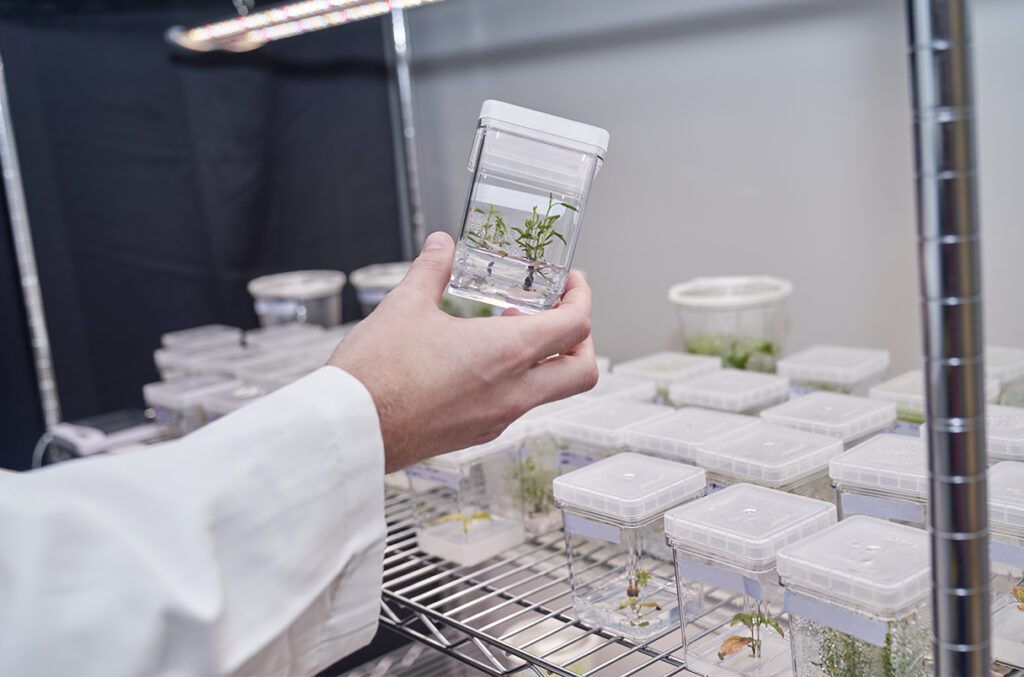A California biotech company seeking to help fight climate change is using the power of plants to create a new tool for that fight: genetically modified trees that grow fast and can literally devour carbon from the atmosphere.
As The New York Times reports, last week in Georgia, the young startup Living Carbon planted a forest of genetically modified poplar seedlings. These seedlings grow almost twice as fast as regular trees and can rapidly soak up atmospheric carbon dioxide. The trees could also reach harvestable maturity in half the time, which normally takes 50 years.
This was the first known planting outside of a research trial or commercial fruit orchard. “To my knowledge [the approach] has never been tested in a tree before,” says Steve Strauss, a forest geneticist at Oregon State University, Corvallis, who serves on Living Carbon’s scientific advisory board and is collaborating with the company on research.
A photosynthesis and GM combo
Living Carbon’s scientists focused on the rate of photosynthesis, which is one key constraint in trees’ atmospheric carbon dioxide absorption process.
Photosynthesis alone is “relatively inefficient,” says an article by Science. This biochemical process produces a toxic byproduct called phosphoglycolate, used by trees to convert carbon dioxide into sugars and ultimately wood, “which the plants must then remove through a process called photorespiration.”
To overcome this issue, Living Carbon’s scientists inserted genes using bacteria from pumpkin and green algae into the poplar trees to tweak photosynthesis.
“The foreign genes enabled the trees to have lower photorespiration rates and to recycle carbon from phosphoglycolate into sugars essential to growth,” Science wrote.
As Living Carbon CEO Maddie Hall noted, faster growth benefits landowners, who “see it as a potential annual revenue stream.” The New York Times writes that the company “has started marketing credits based on carbon its trees will soak up […] to produce an income stream not reliant on venture capital.”
According to Living Carbon, their trees accumulate up to 53% more biomass than control seedlings, which means they soak up more carbon and fight climate change. They can also be planted in poor soil contaminated with heavy metals since their roots soak up the metals from the soil. These metals “naturally slow wood decay,” thus releasing carbon more slowly.
Planting 4 million genetically modified trees
Living Carbon is planning more plantings soon, including at an abandoned coal mine in Pennsylvania, with the goal of planting 4 million trees this year and many more next year.
“If we keep doubling the number of trees we plant every year, by 2030 we will have planted enough trees that over the lifetime of the project would remove 1.66% of 2021 global emissions, which would be over 600 megatons,” Hall believes.
She emphasized how exciting it is for them to see “how interested landowners are in participating in carbon markets” and that they see it “as a potential annual revenue stream.”
“We specifically focus on land where trees otherwise wouldn’t be planted like abandoned mine lands, areas where there isn’t an existing, rich ecosystem that’s allowing for a large amount of carbon removal right now,” Hall points out.
However, as The New York Times wrote, Living Carbon’s project has also attracted critics, such as the environmental group Global Justice Ecology Project, which has called GM poplars “growing threats to forests.”
The Living Carbon’s co-founder Patrick Mellor explains that their modified poplar trees are intentionally all female, so they won’t produce pollen—a fact that should head off environmental concerns.
He pointed out that “while they could be pollinated by wild trees and produce seeds,” their trees are “unlikely to spread into the wild because they don’t breed with the most common poplar species in the Southeast.”




